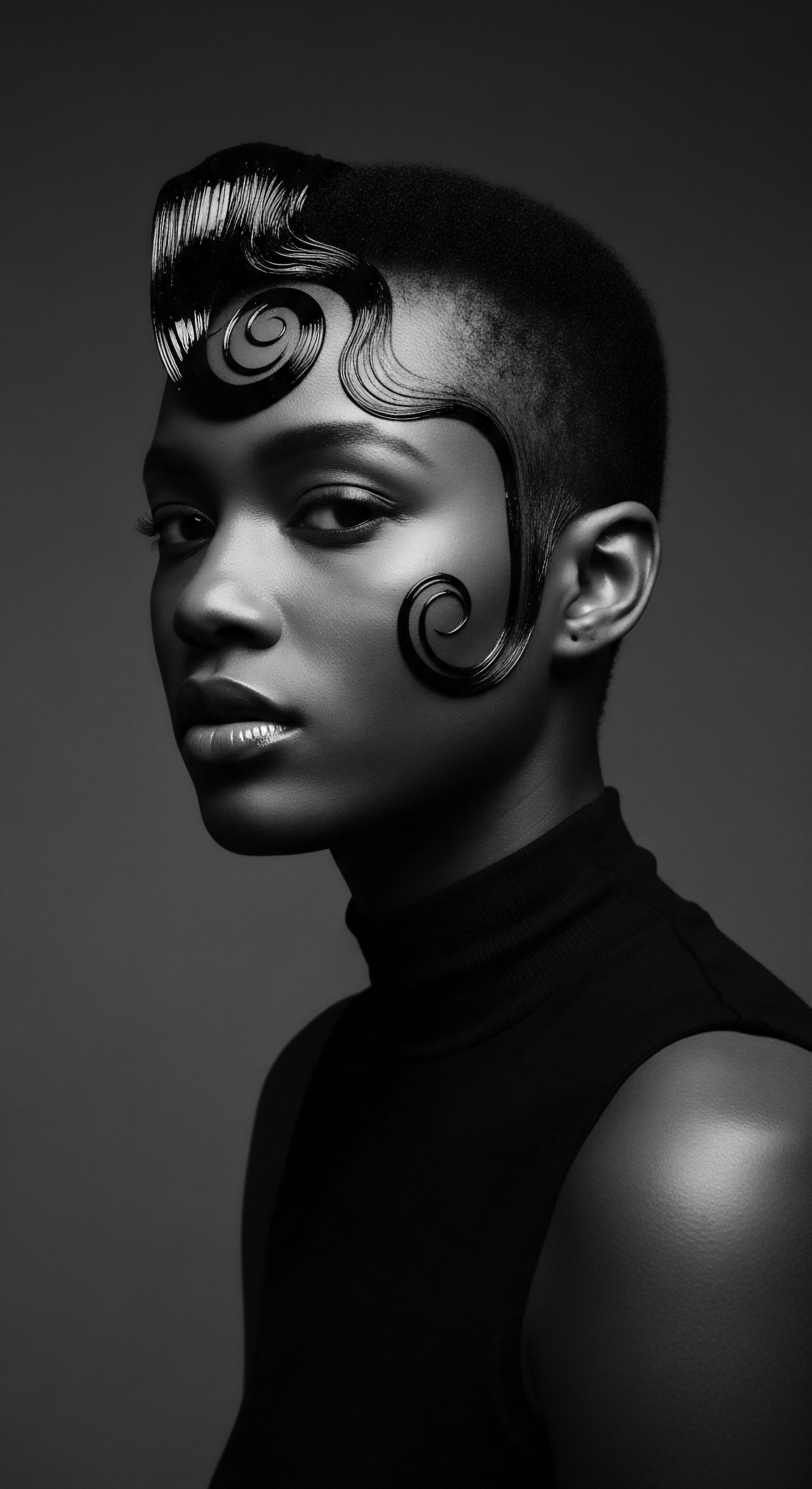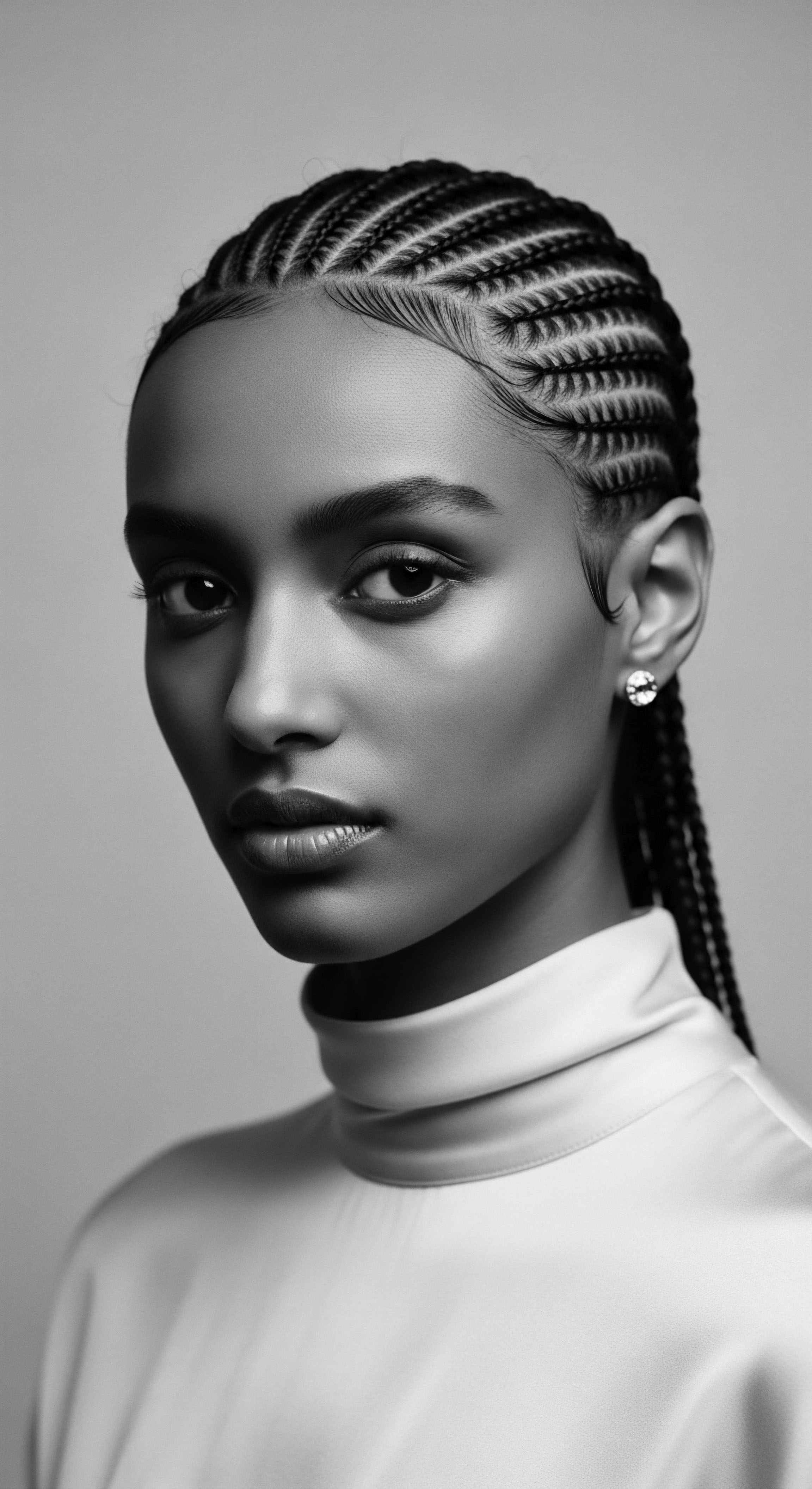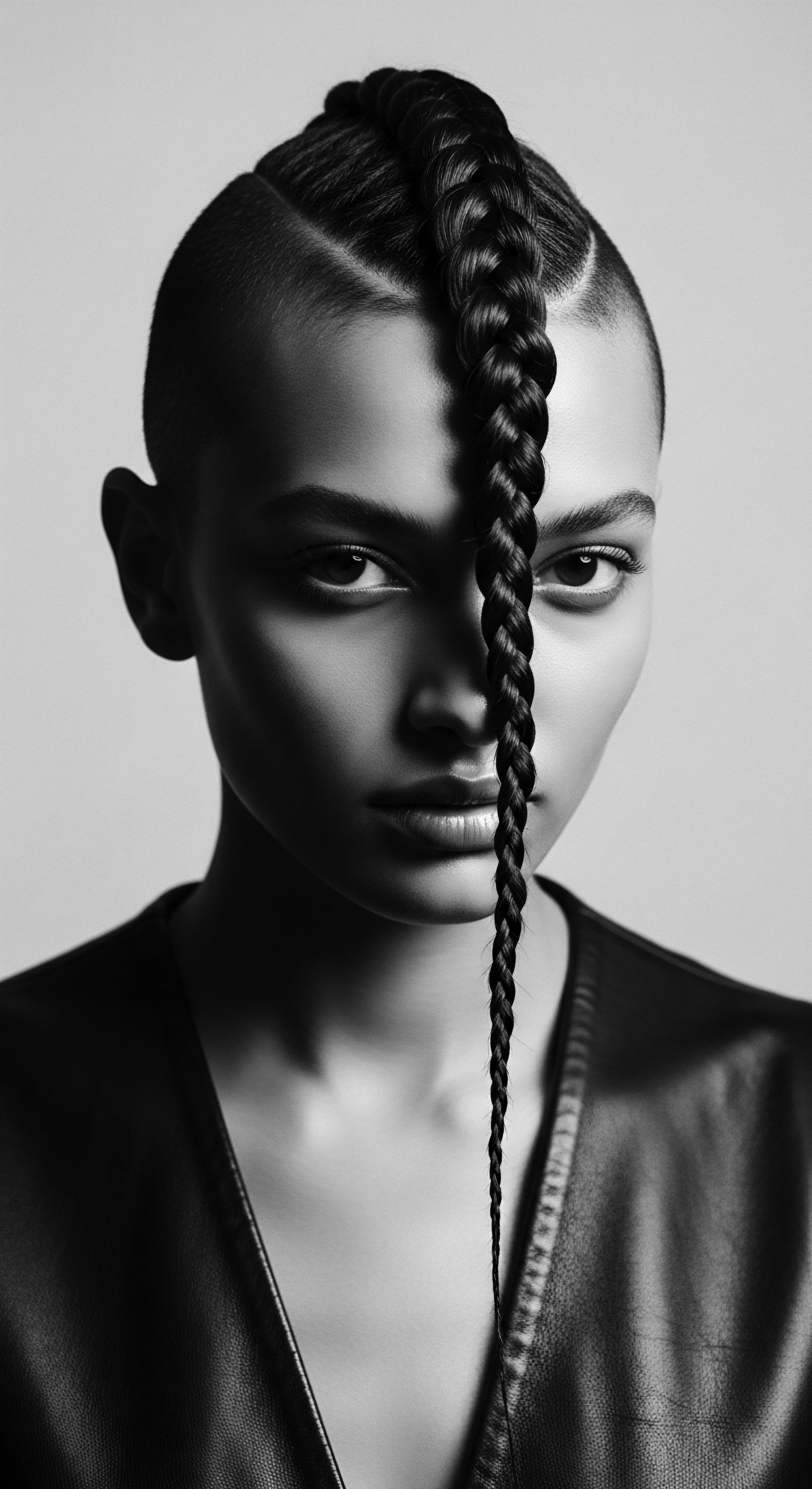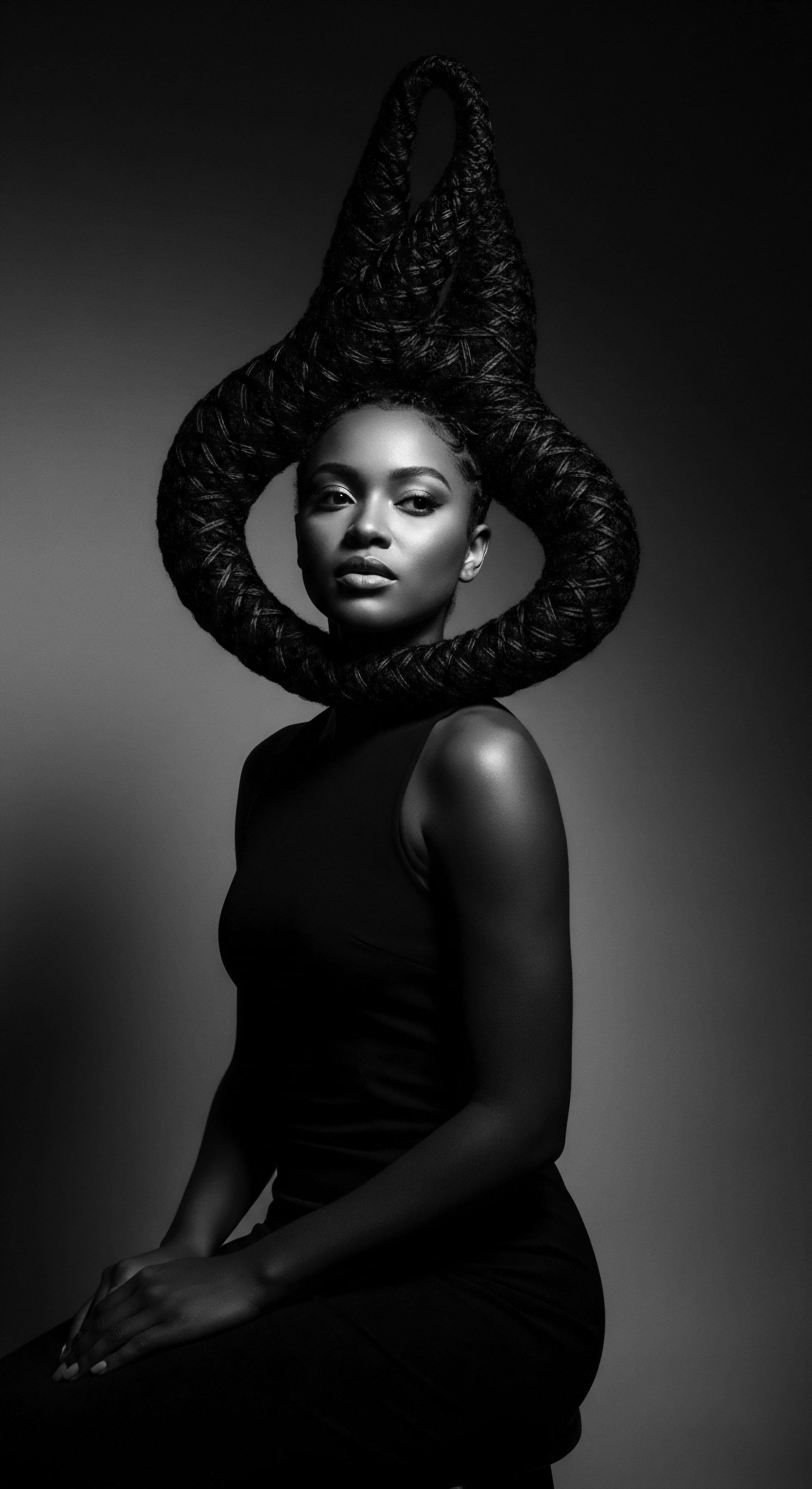
Roots
The very spirals, waves, and coils that crown us hold an ancient dialogue, a quiet but potent conversation with the earth and the wisdom of those who walked before. For many with textured hair, this crown is no mere adornment; it is a living map, tracing paths of migration, survival, and profound beauty across continents and centuries. This inherent connection to the soil, to the very plants that nourished our ancestors, forms the bedrock of textured hair wellness, linking contemporary care to a heritage of botanical grace.

The Hair Strand’s Ancient Blueprint
Each textured hair strand possesses an architectural wonder, a structural particularity that distinguishes it from other hair types. Its elliptical shape, combined with varied angles of growth from the scalp, establishes its distinctive curl pattern. The cuticle layers, often raised in curly patterns, possess unique needs for moisture retention, a fact understood intuitively by ancestral caregivers long before modern microscopes revealed the cellular mechanics. Traditional plant-based remedies, often passed down through familial lines, often addressed this fundamental need for moisture and protection, acting as a balm against environmental challenges.
Consider, for a moment, the hair follicle itself. This tiny organ, nestled beneath the skin, dictates the strand’s formation. In textured hair, these follicles are often crescent-shaped, influencing the strand to emerge with its characteristic twist or bend. The distribution of keratin, the protein that makes up hair, tends to be unevenly distributed in highly coiling strands, contributing to points of fragility.
Remedies from antiquity, rich in mucilage and fatty acids, provided lubrication and strength, compensating for these natural vulnerabilities. These were not random acts; they were responses born from keen observation and generational experimentation.
Textured hair, with its unique structural qualities, silently carries the biological memory of ancestral environments and care practices.

Language of Hair and Land
The classifications we use today for textured hair, while often rooted in scientific observation, frequently overlook the vibrant, descriptive languages used within diverse communities to speak of their hair. Beyond numerical types, there existed a nuanced lexicon, describing not just curl pattern but texture, sheen, and responsiveness to specific botanicals. Think of the specific terms for hair textures in West African languages, or the ways Indigenous peoples described hair quality in relation to environmental factors. These words were often intrinsically linked to the plants and practices used for care.
The concept of ‘good hair’ or ‘bad hair,’ a colonial construct that caused much pain within Black communities, often dismissed the inherent strength and beauty of highly coiling hair, along with the traditional methods that nurtured it. Reclaiming traditional plant wisdom helps dismantle these damaging narratives, affirming the inherent health and beauty of all textures as they exist in their natural state. It is a return to a language of reverence.

Hair Growth Cycles and Earth’s Rhythms
Hair growth follows a cyclical pattern ❉ anagen (growth), catagen (transition), and telogen (rest). While universal, environmental and nutritional factors, deeply tied to geographical regions and dietary traditions, influenced these cycles. Ancestral diets, rich in specific vitamins and minerals derived from local plant sources, directly contributed to scalp health and hair vitality. The knowledge of which herbs stimulated growth or soothed irritation was interwoven with an understanding of the body’s connection to the land.
For instance, the use of nettle (Urtica dioica) infusions for scalp stimulation, a practice common across various European and African traditions, speaks to an inherited recognition of its circulatory benefits. Similarly, the widespread application of aloe vera (Aloe barbadensis miller) for scalp soothing across African and Indigenous American cultures points to its universally recognized emollient properties, which support a healthy environment for hair growth (Stewart, 2013). These remedies were not isolated treatments; they were part of holistic practices that considered the entire being in harmony with its surroundings.
The cycles of hair growth found their parallel in the cycles of nature. The planting, harvesting, and preparation of plant remedies followed seasonal shifts, ensuring potency and availability. This deep respect for natural rhythms guided hair care just as it guided agriculture and healing. The hair, in essence, became a reflection of the earth’s own vitality.

Ritual
The application of plant-based remedies to textured hair transcends simple cosmetic action; it enters the realm of ritual, a deliberate, repeated act steeped in cultural memory and personal dedication. These rituals, whether daily anointing or weekly cleansing, formed the scaffolding of care for generations, shaping not only the health of the strands but the very experience of self and community. The efficacy of these traditional applications often lay not just in the chemistry of the botanicals, but in the sustained, mindful attention they fostered.

Ancestral Roots of Protective Styling
Protective styling, a cornerstone of modern textured hair care, finds its deepest roots in ancestral practices. Styles such as braids, twists, and locs were not merely aesthetic choices; they were strategic defenses against environmental elements, tools for managing hair growth, and powerful markers of identity. Plant-based remedies played an indispensable role in preparing the hair for these styles, nourishing the scalp, lubricating the strands, and providing pliability.
The application of plant oils, such as shea butter from West Africa or coconut oil in many diasporic communities, prior to braiding, offered slip and sealed in moisture. This reduced friction and breakage, allowing styles to last longer and hair to retain length. The purposeful layering of these emollients before a long-lasting style speaks to a sophisticated understanding of hair mechanics, one refined over countless generations. These were practices of preservation, safeguarding the hair’s integrity during periods of extended wear.

Traditional Defining Techniques
The very definition of textured hair patterns, now sought through various products, was once achieved through methods deeply reliant on botanical gifts. Hair defining techniques were often intertwined with the properties of plant-derived ingredients. For instance, the use of gels from flax seeds or the mucilage from okra to clump and hold curls, is a testament to the ingenuity of ancestral caregivers. These natural polymers provided hold without harsh chemicals, allowing the hair to retain its softness and moisture.
Beyond simple hold, these plant-based definers offered therapeutic benefits. Flaxseed gel, for example, is rich in omega-3 fatty acids, which nourish the scalp and hair cuticle. This duality of styling and nourishment is a hallmark of traditional remedies, where beauty and health were inseparable. The act of carefully applying these natural agents, section by section, was a form of tender devotion to the hair.
| Botanical Agent Chebe Powder |
| Traditional Application & Cultural Origin Chad, Central Africa; applied as paste for moisture retention and length preservation, often combined with oils for braids and twists. |
| Modern Understanding of Benefits Contains saponins and emollients that lubricate the hair shaft, reducing breakage. Its particles create a protective layer. |
| Botanical Agent Aloe Vera Gel |
| Traditional Application & Cultural Origin Africa, Americas, Caribbean; used for scalp soothing, conditioning, and curl definition. |
| Modern Understanding of Benefits Rich in enzymes, minerals, and vitamins; acts as a humectant and emollient, promoting moisture and reducing inflammation. |
| Botanical Agent Hibiscus Flowers |
| Traditional Application & Cultural Origin India, West Africa; infusions used as rinses for conditioning, detangling, and promoting shine. |
| Modern Understanding of Benefits Contains mucilage and alpha-hydroxy acids (AHAs) which condition the hair, provide slip, and gently clarify the scalp. |
| Botanical Agent Fenugreek Seeds |
| Traditional Application & Cultural Origin North Africa, Middle East, India; soaked seeds create a mucilaginous paste for conditioning, strengthening, and growth promotion. |
| Modern Understanding of Benefits Rich in protein, nicotinic acid, and lecithin, which are believed to strengthen hair, reduce shedding, and stimulate follicles. |
| Botanical Agent These plant-based practices illustrate the enduring wisdom applied to textured hair health across generations. |

Tools and Heritage of Care
The tools of textured hair care, from wide-tooth combs carved from wood to simple fingers adept at manipulation, were often paired with plant-based emollients. The smooth glide provided by oils and butters allowed for detangling with minimal stress to the hair, preventing the breakage that harsher methods might inflict. The deliberate choice of materials for combs and brushes, often natural, resonated with the natural ingredients being used.
Consider the simple act of finger detangling, softened by a plant-derived conditioner. This approach, emphasized in many traditional practices, respects the hair’s natural elasticity. The plant remedy becomes an extension of the hand, facilitating a gentle process that honors the hair’s delicate nature.
The consistent, purposeful application of plant wisdom transformed simple care into deeply ingrained hair rituals.

Wigs, Extensions, and Historical Meaning
The story of wigs and hair extensions, often viewed as modern accessories, reaches back into profound historical and cultural contexts, particularly within African and diasporic communities. These were not always about concealment; they were frequently expressions of status, spirituality, and artistic identity. Plant-based remedies were essential for maintaining the wearer’s natural hair beneath these elaborate constructions, preventing damage and promoting scalp health.
Before intricate extensions were installed, scalps were often massaged with nourishing plant oils and herbal infusions to create a healthy foundation. This preparation was as critical as the styling itself, recognizing that the health of the concealed hair directly impacted the overall well-being of the wearer. This sustained the hair’s health, ensuring that protective styles offered true protection.

Relay
The journey of plant-based remedies, from ancient practices to their contemporary influence on textured hair health, represents a powerful relay of knowledge across generations and geographies. This is not a static history; it is a dynamic, living archive where ancestral ingenuity meets modern scientific inquiry, validating the profound efficacy of traditional approaches. The intricate interplay of botanical chemistry, cultural context, and lived experience forms a comprehensive understanding of hair wellness.

Validating Ancestral Wisdom
Modern scientific exploration often confirms what ancestral communities knew through observation and inherited wisdom. The saponins in soap nuts (Sapindus mukorossi) used as a gentle cleanser, the humectant properties of agave nectar , or the emollient benefits of baobab oil from the African continent, now find scientific validation. This convergence of traditional knowledge and laboratory analysis strengthens the credibility of plant-based remedies.
One compelling example lies in the use of Chebe powder by women of the Basara Arab tribe in Chad. Traditionally, this blend of specific herbs (including lavender crotons, Mahllaba soubiane, Missic, cloves, and Samour resin) is mixed with oils and applied to the hair (Duvivier, 2022). The practice involves wetting the hair, applying the oil mixture, then layering with Chebe powder before braiding. This ritual, repeated every few days, has been observed to contribute to remarkable hair length and strength, reaching waist or even floor-length (Duvivier, 2022).
Scientific examination suggests that the small, hard particles in Chebe powder, combined with oils, create a protective barrier around the hair shaft, reducing mechanical friction and moisture loss. This explains how hair that is inherently prone to breakage can achieve such length, not by accelerating growth, but by preserving existing length through ancestral protective measures. The women’s traditional method, passed down orally, effectively minimizes environmental stressors and manipulation breakage, principles now recognized by modern trichology as fundamental for length retention in textured hair.
The efficacy of time-honored botanical remedies is often affirmed by contemporary scientific investigation.

Interweaving Botanicals and Hair Biology
The impact of traditional plant-based remedies on textured hair health can be understood through their chemical composition and how these compounds interact with the hair’s biology. Many traditional remedies are rich in:
- Mucilages These slimy, gel-like substances found in plants like slippery elm bark or marshmallow root provide exceptional slip and detangling properties, reducing mechanical stress on fragile textured strands during manipulation. They coat the hair, creating a protective layer.
- Fatty Acids and Lipids Oils such as jojoba oil (mimicking sebum), argan oil , or castor oil are abundant in nourishing fatty acids. These lipids penetrate the hair shaft or sit on its surface, reinforcing the natural lipid barrier, preventing moisture loss, and adding elasticity to the hair.
- Proteins and Amino Acids Certain plant extracts, like those from rice water or horsetail , contain amino acids that can temporarily fortify the hair’s protein structure, offering a gentle strengthening effect without causing stiffness.
- Antioxidants and Anti-Inflammatory Compounds Found in herbs like rosemary or neem , these compounds help soothe scalp irritation, reduce oxidative stress, and create a healthy environment for hair follicles, which is paramount for overall hair vitality.
The holistic approach of traditional remedies meant these compounds were often applied in synergy, rather than isolated. A combination of cleansing herbs, nourishing oils, and strengthening rinses created a comprehensive regimen, addressing multiple aspects of hair health simultaneously.

Global Echoes of Plant Wisdom
The application of plant-based remedies is not confined to one region; it is a global phenomenon with shared principles across diverse cultures, each adapting to their local flora. The use of oils, herbs, and earth-derived materials for hair care represents a universal human understanding of nature’s restorative power.
For example, the practice of hair oiling is ubiquitous, yet the oils used vary by region:
- Indian Subcontinent ❉ Utilizes oils such as Amla Oil, Bhringraj Oil, and Coconut Oil, often infused with specific herbs for growth and conditioning.
- West Africa ❉ Features Shea Butter, Baobab Oil, and Moringa Oil, valued for their emollient and protective qualities in often arid climates.
- Caribbean and Latin America ❉ Employs Castor Oil, Avocado Oil, and various herbal concoctions, reflecting a blend of African, Indigenous, and European botanical traditions.
- Indigenous North America ❉ Incorporated plant extracts from Yucca, Bearberry, and various barks and roots for cleansing, strengthening, and protection.
These distinct regional approaches, while using different ingredients, share a common thread ❉ the deep belief in the plant kingdom’s ability to heal, protect, and enhance the vitality of textured hair. They represent a collective ancestral wisdom, relayed through generations, adapting but never abandoning its roots in the earth. The integration of modern research techniques with these venerable practices opens new avenues for sophisticated, heritage-informed hair care.

Reflection
The narrative of textured hair health, particularly as it intersects with traditional plant-based remedies, is a continuous story, a living testament to resilience. It speaks of the earth’s sustained generosity and the enduring ingenuity of those who learned its secrets. Each strand, in its intricate formation, carries the memory of landscapes, hands that cared, and remedies whispered down through time.
Our understanding of hair’s elemental biology, once intuitive knowledge passed through lineage, now finds its echo in scientific validation. The simple act of anointing hair with a plant oil, once a daily ritual woven into existence, holds layers of protection and nourishment confirmed by modern analysis. This convergence does not diminish the sacredness of tradition; it amplifies it, adding another dimension to our appreciation of ancestral wisdom.
Roothea’s ‘Soul of a Strand’ ethos is more than a philosophy of hair care; it is an invitation to listen closely to these echoes from the source, to recognize the tender thread of care that connects us to our past. It is about honoring the living archive within each coil and curl, understanding that the choices we make for our hair today are informed by centuries of cultural practice and botanical knowledge. Our hair stands as an unbound helix, a powerful expression of identity, history, and a future deeply rooted in heritage.

References
- Stewart, A. (2013). Hair Story ❉ Untangling the Roots of Black Hair in America. St. Martin’s Press.
- Duvivier, K. (2022). The Science of Black Hair ❉ A Comprehensive Guide to Textured Hair Care. Independently published.
- Walker, A. (2019). Tapestry of Hair ❉ Black Women’s Hair in Cultural Context. University of California Press.
- Porter, R. (2007). The Cambridge History of Science ❉ Volume 4, Eighteenth-Century Science. Cambridge University Press.
- Bell, L. (2016). African Botanical Beauty ❉ Rituals and Recipes for Health and Radiance. Llewellyn Publications.
- Choudhury, N. (2018). Herbal Medicine ❉ Biomolecular and Clinical Aspects (2nd ed.). CRC Press.
- Opoku-Nsiah, J. (2014). Traditional Hair Care Practices in Ghana ❉ A Cultural Perspective. University of Ghana Press.
